At Buysman Kruiden, they’re dedicated to cultivating potted herbs of the highest quality. The herbs have lots of space, and the company uses innovative, sustainable methods. In this way, this Dutch family business distinguishes itself in the herb sector. These herbs are slightly more expensive than cut herbs. Cut herbs might be convenient, but consumers are better off with potted herbs, Piet Buijsman points out. People can pick their herbs straight from the pots, so they're always fresh and, therefore, tastier.
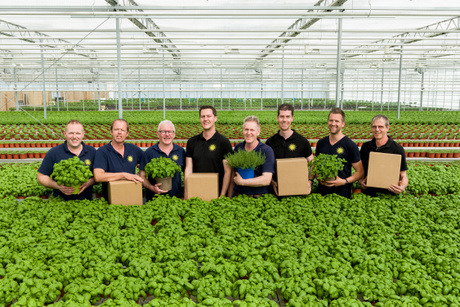
Generation 3 and 4 at Buysman Kruiden
The Buijsmans have been farming for generations. Almost 40 years ago, they started growing chives. “Chives are biennial and grow outside for the first year,” explains Piet. “In the autumn, we uproot and freeze these plants and then place them in pots. They’re stacked closely together, five layers high, in a growth cell.” This intensive form of cultivation is now called vertical farming, but Buysman Kruiden was doing it in 1983 already.
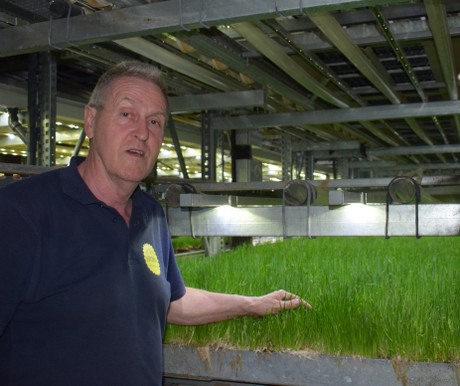
Piet Buijsman with the chives
Chives are the only herb in the nursery’s assortment that can cope with little room and light. It’s root ball already contains all its growing power. All the other herbs get more space. The business now has 11.000 m2 of greenhouses. They have ebb-and-flow tables for another 12 herb varieties. There’s basil, coriander, parsley, thyme, mint, and sage, lemon melissa, lemon basil, red shiso, basil piccolino, chocolate mint, and Swiss mint. Each variety has its preferred growing conditions. Basil, for example, is a tropical plant that needs warmth, while parsley can do with slightly lower temperatures. The greenhouses have seven separate parts with different lighting and climate plans. These are used to allow each kind of herb to grow as well as possible.
Innovation and sustainability have always been this company’s pillars for further development. The Buijsmans were one of the first to start cultivating under LED lights. Now, the second LED generation is on the way. The latest greenhouses have been fitted with diffused glass. That ensures optimal daylight by allowing six to seven percent more light in, with less shade.
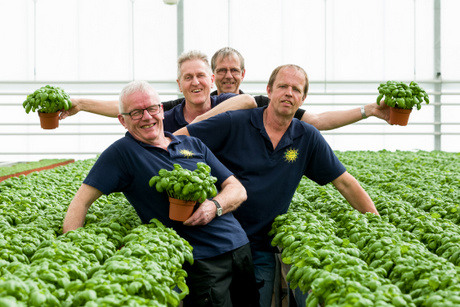
3th generation Buijsman
The farming is done sustainably and chemical-free. The farm uses preventative ‘bio-weapons’ like parasitic wasps and predatory insects. These prevent diseases and pests, so Buysman Kruiden doesn’t have to use any pesticides. “Except for fertilizers, we farm organically,” continues Piet. “We purposefully chose to do so because conventional fertilizers ensure better quality herbs. Organic fertilizers seem to be less effective, especially in autumn. Compare the herbs to elite athletes. After all, don’t you provide these with the best nutrients so that they can perform at their peak?”
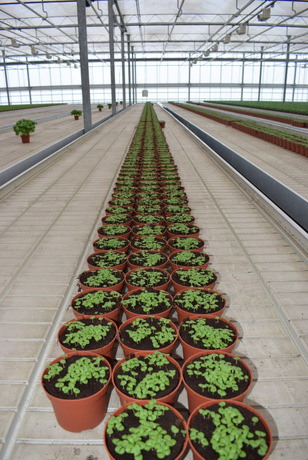 These herbs still have enough space in the pot to develop
These herbs still have enough space in the pot to develop
The greenhouses are heated by both geothermal heat and gas. The company expects to be able to switch to hydrogen in the future. Already, 300 solar panels generate some of the energy they use, and the sustainable LED lighting system saves 40% on power consumption. They also recirculate 100% of their water.
“Near the nursery, we have about 5 million liters of water reserved in basins, which means we have a two-year supply. The herbs grow on ebb-and-flow tables, and we reuse all this water. As a result, we make optimal use of the fertilizers. Not a single drop of water ends up back in the environment.”
Packaging issues were well-considered, but, for now, recycled plastic is the best option. “Organic, compostable plastic takes very long to degrade or must happen under high temperatures. The eventual footprint for cardboard and paper pots is higher than that of rPET,” Buijsman says.
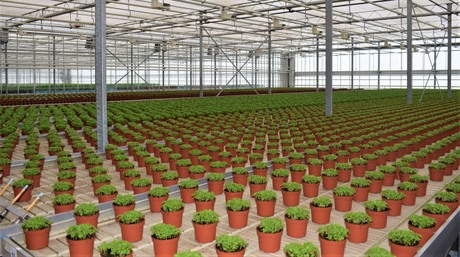 Later on herbs are given space to develop
Later on herbs are given space to develop
“High temperatures are also needed to produce paper and cardboard, and they’re heavier to transport. We’re currently doing a trial with potless cultivation, which seems to be a good farming alternative. It, however, requires an accelerated trading channel since the root ball’s underside quickly disintegrates when it dries out.”
Buysman Kruiden markets its herbs under their own brand. Selling 1,5 million herb pots a year makes them the second largest herb supplier in the Netherlands. Most of the potted herbs go directly to Dekamarkt, Deen, and Landmarkt supermarkets. These pots are also sold to markets and greengrocers via wholesalers. Buysman Kruiden has a range of larger sized potted basil, mint, and thyme too.
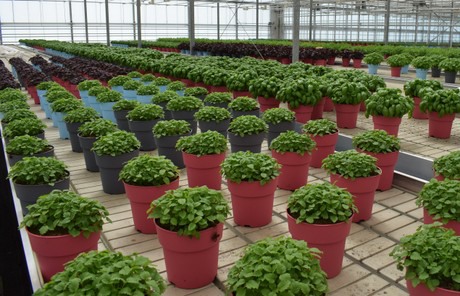 The larger pot sizes with herbs for the terrace and balcony
The larger pot sizes with herbs for the terrace and balcony
These are suited to terraces and balconies and are available at gardening centers, where the sell particularly well in the spring. “You can buy a wider variety of herbs at gardening centers than in stores. However, not year-round, since these are no longer available there after the summer.” The nursery also has a direct sales channel for consumers. People can order a herb box from the webshop. This is a great alternative to a lovely bunch of flowers and is sent, by post, to your door.
Piet and his family haven’t yet considered cultivating edible flowers. But, their link to the flora world widened the company’s sales channel outside of fruit and vegetable trading. Herbs fall under edible plants and flowers, so Buysman Kruiden entered into a fruitful collaboration with Flora Holland.
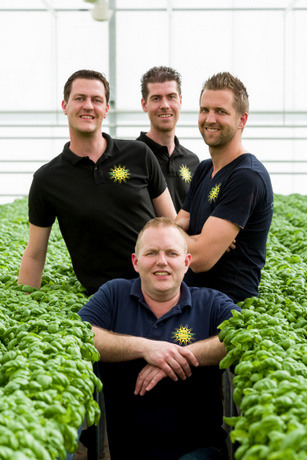
4th generation Buysman
“We started with this last year, and you can see the sales rising sharply. Everything revolves around brand awareness, and we are fully committed to that. On 1 January, we renewed our house style, and we ensure that we participate in trade shows. You can see the number of countries gradually increasing”, Piet Buijsman says.
Remote destinations are challenging for potted herbs. “We, therefore, export mainly to (the Netherlands’) surrounding countries - Germany, Belgium, the United Kingdom, Ireland, and France. But we exporting to the Baltic states, and even Aruba is possible. There is no limit as long as transportation goes well. We harvest the herbs fresh in the morning and cover them. Then, they’re good to go in the trade channel for another week or so. After that, the plants need light.” Once on the shelf, the plants keep well again; all they need is a little light and moisture.
Potted herbs have to survive for a long time in the trade channel and then in consumers’ homes. So, they must be of good quality. “We work with fixed prices throughout the year. These might be slightly higher than those of fellow growers. That’s because we choose to give our plants more space. That allows them to grow better. In the end, that benefits everyone in the chain. When losses are taken into account, we’re no more expensive than the others,” Piet concludes.
Voor meer informatie: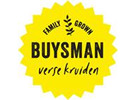 Buysman Kruiden
Buysman Kruiden
Kadijkweg 41
1619 PJ Andijk
Tel: 0228-597161
info@buysmankruiden.nl
www.buysmankruiden.nl
